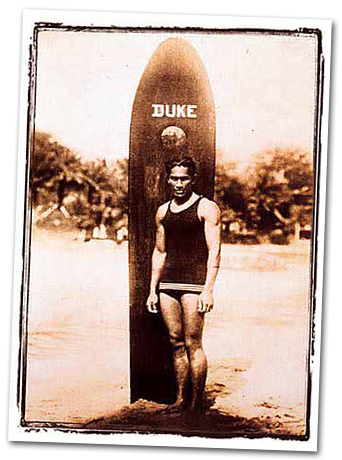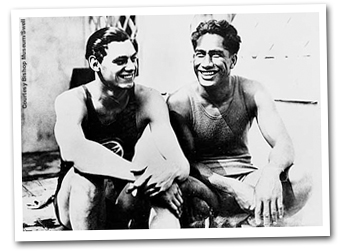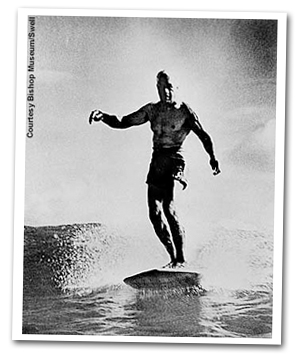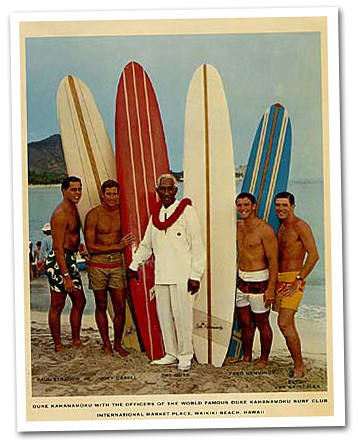
 Duke Paoa Kahinu Mokoe Hulikohola Kahanamoku
(August 24, 1890 ® January 22, 1968), was born in Hawaii on August 24, 1890. He is generally regarded
as the father of modern surfing, Olympic champion and legendary waterman. Duke Paoa Kahinu Mokoe Hulikohola Kahanamoku
(August 24, 1890 ® January 22, 1968), was born in Hawaii on August 24, 1890. He is generally regarded
as the father of modern surfing, Olympic champion and legendary waterman.
The name "Duke" is not a title, but a given name. He was named after his father, Halapu Kahanamoku, who was christened "Duke"
by Bernice Pauahi Bishop in honor of Prince Alfred, Duke of Edinburgh, who was visiting Hawaii at the time of the elder man's
birth in 1869. The younger "Duke," as eldest son, inherited the name.
Growing up on the outskirts of Waikiki (near the present site of the Hilton
Hawaiian Village), Kahanamoku spent his youth
as a bronzed beach boy. It was at Waikiki Beach
where he developed his surfing and swimming skills.
Duke along with his teenage surfer friends formed
one of the first surf clubs known as Hui Nalu or 'Club
Of The Waves'. They were also known as the 'Beach
Boys of Waikiki'. At that time in Hawaii the missionaries
had stamped out all native traditions, through fear
of the unknown, surfing or wave-sliding as it was
known at the time was one of these. Duke and his
friends are credited with the rebirth of surfing
in Hawaii.
In his youth, Kahanamoku preferred an old-school (traditional) surf board, which he called his "papa nui", constructed after
the fashion of ancient Hawaiian "olo" boards. Made from the wood of a koa tree, it was sixteen feet (4.8 m) long and weighed
114 pounds (52 kg). The board was without a skeg, which had yet to be invented. In his later career, he would often use smaller
boards, but always preferred those made of wood.
On August 11, 1911, in an amateur swim meet, Kahanamoku was timed at 55.4 seconds in the 100 yard (91 m) freestyle, beating the
 existing world record by 4.6 seconds, in the salt water of Honolulu Harbor. He also broke the record in the 220 yd (201 m) and
equaled it in the 50 yd (46 m), but the Amateur Athletic Union, in disbelief, would not recognize these feats until many years
later. They initially claimed that the judges must have been using alarm clocks rather than stopwatches, and later claimed that
ocean currents aided Kahanamoku. existing world record by 4.6 seconds, in the salt water of Honolulu Harbor. He also broke the record in the 220 yd (201 m) and
equaled it in the 50 yd (46 m), but the Amateur Athletic Union, in disbelief, would not recognize these feats until many years
later. They initially claimed that the judges must have been using alarm clocks rather than stopwatches, and later claimed that
ocean currents aided Kahanamoku.
Kahanamoku easily qualified for the U.S. Olympic swimming team in 1912, breaking the record for the 200 meter freestyle in his
trial heat for the 4x200 relay. He went on to win a gold medal in the 100 meter freestyle in the 1912 Olympics in Stockholm,
and a silver with the relay team, catapulting him into international stardom. Eight years later he repeated this, during the 1920 Olympics in Antwerp,
he won gold medals both in the 100 meters, bettering fellow Hawaiian Pua Kealoha, and in the relay. He finished the 100 meters with a silver medal
during the 1924 Olympics in Paris, the gold going to Johnny Weissmuller and the bronze to Duke's brother, Samuel Kahanamoku. He also showed up on
the U.S. Water Polo team at the 1932 Summer Olympics. All told, Duke won three gold and two silver medals in four Olympic games.
 Between Olympic competitions, and after retiring from the Olympics, Kahanamoku traveled internationally, particularly Australia
and the United States, to give swimming exhibitions. It was during this period that he popularized the sport of surfing, previously
known only in Hawaii, by incorporating surfing exhibitions into these visits as well. His surfing exhibition at Sydney's Freshwater
Beach on December 23, 1914 is widely regarded as the most significant day in the development of surfing in Australia. The board
Kahanamoku used is retained by the Freshwater Surf Club and can be viewed if the caretaker is approached respectfully. There is a
statue of Kahanamoku on the headland at Freshwater. He also made surfing popular in mainland America first in Santa Cruz, California.
This is where surfing first started in California. Between Olympic competitions, and after retiring from the Olympics, Kahanamoku traveled internationally, particularly Australia
and the United States, to give swimming exhibitions. It was during this period that he popularized the sport of surfing, previously
known only in Hawaii, by incorporating surfing exhibitions into these visits as well. His surfing exhibition at Sydney's Freshwater
Beach on December 23, 1914 is widely regarded as the most significant day in the development of surfing in Australia. The board
Kahanamoku used is retained by the Freshwater Surf Club and can be viewed if the caretaker is approached respectfully. There is a
statue of Kahanamoku on the headland at Freshwater. He also made surfing popular in mainland America first in Santa Cruz, California.
This is where surfing first started in California.
During his time living in Southern California, Kahanamoku also performed in Hollywood as an extra and a character actor in several
films, in which he usually played a native chief or a Hawaiian king. In this way, he made connections with people who could further publicity for
the sport of surfing. Kahanamoku was also involved with the Los Angeles Athletic Club, acting as lifeguard and competing on both swimming and water
polo teams.
While living in Newport Beach, California on June 14, 1925, Kahanamoku rescued eight men from a fishing vessel that capsized in heavy
surf while attempting to enter the city's harbor. Twenty-nine fishermen went into the water and seventeen perished. Using his surfboard,
he was able to make quick trips back and forth to shore to increase the number of sailors rescued. Two other surfers saved four more
fishermen. Newport's police chief at the time called Duke's efforts "the most superhuman surfboard rescue act the world
has ever seen."
Thus was born the tradition of lifeguards having rescue surfboards
at the ready.
 In 1940, he married the love of his life, Nadine Alexander. She accompanied him when he traveled all over the world. He also served as sheriff of
Honolulu, Hawaii from 1932 to 1961, serving 13 consecutive terms. In 1940, he married the love of his life, Nadine Alexander. She accompanied him when he traveled all over the world. He also served as sheriff of
Honolulu, Hawaii from 1932 to 1961, serving 13 consecutive terms.
Hawaii music promoter Kimo Wilder McVay capitalized on Duke's popularity by naming his Waikiki showroom Duke Kahanamoku's, and giving Duke a
piece of the financial action in exchange for the use of his name. Duke's was a major Waikiki showroom in the 1960s and is best remembered as
the home of Don Ho & The Aliis from 1964 through 1969.
Duke's name is currently being used by another business establishment, Duke's Canoe Club & Barefoot Bar, a beachfront bar and restaurant in
the Outrigger Waikiki On The Beach Hotel. The decor includes many poster-size photos of Duke ć with his brothers in Waikiki, and on his travels
in other parts of the world. There is a chain of restaurants named after him in California and Hawaii called Duke's.
A monument at Waikiki beach in Honolulu also honors his memory. It shows Duke Kahanamoku standing in front of his surfboard with his arms
outstretched. Many honor him by placing leis on his statue. Do not miss visiting this Waikiki landmark!
In 2002, Kahanamoku was featured on a first class letter rate postage stamp of the United States Postal Service. Pictured on a USA 37¢ commemorative
postage stamp issued 24 August 2002 (112th anniversary of his birth). He was elected to the International Swimming Hall of Fame & Museum in Fort Lauderdale,
Florida, in 1965. Duke Kahanamoku was the first person to be inducted into both the Swimming Hall of Fame and the Surfing Hall of Fame. He was inducted into
the U.S. Olympic Hall of Fame in 1984. The Duke Kahanamoku Invitational Surfing Championships are named in his honor.
The Duke died aged 78 and to this day remains a symbol of Hawaii, one of the greatest surfers
and most important men in surfing history. "The father of modern surfing," was Hawaii's first ambassador of goodwill.
|



